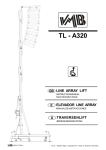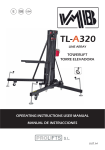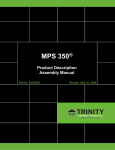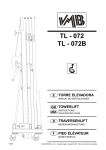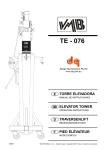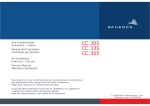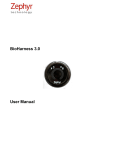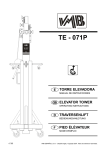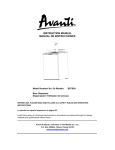Download Nikon TL-A320 User's Manual
Transcript
TL - A320 GB LINE ARRAY LIFT INSTRUCTION MANUAL Quick Operation Guide E ELEVADOR LINE ARRAY MANUAL DE INSTRUCCIONES VMB ESPAÑOLA, S.A. v8.06 - Depósito legal y Copyright 2008. Todos los derechos reservados. TORRE ELEVADORA TOWERLIFT TRAVERSENLIFT PIED ÉLÉVATEUR TL-A320 Fabricante - Manufacturer - Hersteller - Fabricant VMB Española S.A. Calle 2 - Pol. Ind. Picassent E-46220 Picassent (VALENCIA) SPAIN www.vmb.es - e-mail: [email protected] Este manual de usuario y catálogo anexo de piezas de repuesto es propiedad de VMB Española, S.A. Queda prohibida su reproduccion total o parcial por cualquier medio que la tecnología actual permita. Depósito legal y Copyright 2008. Todos los derechos reservados. TL-A320 W N1 X N2 RTS E P1 BU ALS BA C S J F ILS R B H D P T V VMB ESPAÑOLA, S.A. Q v8.06 - Depósito legal y Copyright 2008. Todos los derechos reservados. Quick Operation Guide CONTENTS 1. 2. 3. 4. 5. 6. 7. 1. Introduction. Technical Data. Security. Instructions. Maintenance. Warranty. Certifications. ENGLISH During the life of this towerlift, it may need spare parts for maintenance. In this case please contact your distributor. Only original spare parts must be used. The user loses all rights to warranty if any spare parts other than originals are used or carries out any modification or alteration to the towerlift. For any questions relating to this towerlift please indicate serial number and year of production. INTRODUCTION Thank you for choosing VMB Towerlifts. You have acquired a first class, quality product used by professionals around the world. 2. TECHNICAL IINFORMATION To be able to work with this tower, lifting and flying PA and Line Array, please pay special attention to this manual. Please observe the technical data and follow all instructions fully for a correct and safe use. This manual should also be made available and remain with the towerlift. 2.2 – Especially designed for lifting and flying Line array directly from the floor to a height of 6m. Able to hang at 50cm from the main body of the lift. All VMB towerlifts undergo a strict quality control to guarantee the maximum safety and durability. 2.4 – Minimum Load : Can lift or lower without load. The TL-A320, has been especially designed and engineered to hang Line Array to a maximum height of 6m and a load of 320kg. This lift is capable of situating the PA 50cm from the body of the lift. The benefit of placing the load at a distance enables the user to achieve the perfect curve and coverage for the Line array flown. The TL-A320, incorporates the ALS system (Auto-Lock-Security), ILS system (InertiaLock-Security) and RTS system (RetentorSystem) all exclusive to VMB and which guarantee the load will not fall and provide complete security. ATTENTION: Do not use this towerlift if you have not read and understood the instructions. VMB ESPAÑOLA, S.A. 2.1 – Towerlift mod. TL-A320 2.3 – Maximum load : 320 Kg. at 50 cm from lift body.. 2.5 – Maximum Height : 6 m. 2.6 – Folded Height : 1,98 m. 2.7 – Base Surface : Diagonal 2,78 x 2,78 m. 2.8 – Transport Weight : 182 Kg. 2.9 – Construction Material : 6082-T6 aluminium for the main body comprised of 4 profiles and lifting carriage. DIN 2394 steel for the base and outriggers. ST-37 steel for the ALS security system and pulleys. 2.10 – Security Systems: ALS (Auto-LockSecurity), ILS (Inertia-Lock-Security) which guarantee complete security at all times. RTS (Retentor-System) which guarantees the profiles lift in order. v8.06 - Depósito legal y Copyright 2008. Todos los derechos reservados. Quick Operation Guide ENGLISH 2.11 – 1200kg Manual winch with automatic disc brake. 2.15 – Spirit level to adjust vertical positioning. 2.16 – All lift elements are finished in polyester satin black. 2.12 - Cable : DIN 3060 steel. 180 Kg/mm2 quality antitorsion. 6 mm diametre. 2.17 – 360º Wheels for ease of transport to work place. 2.13 – Adjustable stabilisers on the outriggers with anti-slip injected rubber base. 2.14 – Outriggers fixed with security locks. 3. SAFETY PRECAUTIONS. ! 3.1 – The TL-A320 is designed for lifing Line Array and should never be used for elevating persons. 3.2 - Only situate the lift on hard, flat surfaces checking that it is in a vertical position with the spirit level (F) included. If necessary, adjust with support stabilisers (Q) by turning the handle (H). Do not use any other materials to balance the lift. 3.3 – Check all outriggers are inserted correctly and locked with security locks. VMB ESPAÑOLA, S.A. v8.06 - Depósito legal y Copyright 2008. Todos los derechos reservados. Quick Operation Guide ENGLISH 3.4 – Never elevate the Line Array before checking it is correctly attached to the lift. Kgs 3.5 – Never exceed the maximum weight indicated on the towerlift and in this manual. 3.6 – If there is excessive wind, place the lift on firm ground and attach slings to add stability. Never attach a sling to a vehicle or any other element than can move. 3.7 – Do not use a ladder on the lift. 3.8 – Be carfeful of any high, obstructions such as balconies, signs etc. It is important to avoid the presence of cables beneath the working position of the lift. VMB ESPAÑOLA, S.A. v8.06 - Depósito legal y Copyright 2008. Todos los derechos reservados. Quick Operation Guide ENGLISH 3.9 – Never stand below the raised material and do not allow others to stand beneath or around the working area of the lift. 3.10 – Never try to move the lift once the load is raised. 3.11 – Never use the lift on a mobile surface or on any vehicle. 3.12 – Before using the lift check the condition of the cable. The cable should not be broken or torn. NEVER use defect cables and if in doubt change the cable. Only use DIN 3060 steel cable 180 Kg/mm2 quality torsion resistant cable. 3.13 – Never remove the handle from the winch if the lift is elevated with load. VMB ESPAÑOLA, S.A. v8.06 - Depósito legal y Copyright 2008. Todos los derechos reservados. Quick Operation Guide ENGLISH -25 3.14 – The minimum load for the brake functioning in the winch is 25kg. Without this weight the brake will not function. 3.15 – Do not grease or lubricate the break mechanism in the winch. The break discs have been especially greased with a special anti heat, pressure material. Other products must not be used so as to avoid the break not working effectively. 3.16 – All profiles must be lowered before the lift is transported. 3.17 – Only original spares must be used. O R IG INAL VMB ESPAÑOLA, S.A. v8.06 - Depósito legal y Copyright 2008. Todos los derechos reservados. Quick Operation Guide 4. INSTRUCTIONS. 4.1 - Situate the lift on its transport wheels (T) upon a flat and stable surface. When erecting the lift in open air, the risk of wind is prevalent. Where wind speeds exceed 30 Km/h it is essential to tie the lift. 2 lateral fixing points (X) are situated at the top of profile 2, where tensors should be attached and fixed on secure and firm ground (NEVER ON A VEHICULE OR ANYTHING THAT CAN MOVE). 4.2 – Remove the outriggers from their transport compartments (S) and place them in the working position (V) ensuring they are fixed with the security locks (R). The long outriggers are placed and the front beneath the load. The short outriggers are placed at the back. 4.3 – Remove the front support bars (BA) from their transport compartment (S) and place them in their corresponding fixed position (D) on each front outrigger and at the top of the first profile (E) ensuring they are fixed with the pins provided BU/P1. To correctly fix the front support bars (BA), adjust the support of the front outrigger by turning the stabiliser handel in the necessary direction. Insert clips (BU) and security pins (P1). ENGLISH Support FAS-01 is to be fixed to the forks by either 1 or 2 points. See fig. 1. If the Line Array Buffer has 4 link points use the FAS-02 support which enables the Line Array to be flown from 4 points, see fig. 2. Both supports FAS-01 and FAS-02 are inserted on the forks as follows: The Line Array cabinets will be attached to their buffer with the angles calculated according to the acoustic coverage required. This ensures the Line Array cabinets can be curved in function with the necessary degrees required between them. The system should be attached at the necessary distance to achieve the required curve. The last cabinet should not hit the body of the lift. See fig. 3. To ensure the maximum security margin it is necessarry to always attach the Line Array at the minimum distance possible from the body of the lift. This will mean that the bottom cabinet is as close as possible to the body of the lift. See fig. 3A. To avoid overloading do not seperate uneccessarily the Line Array from the body of the lift. See fig. 3B. Adjust the vertical position of the lift with the stabilisers (Q) turning the handels so that the spirit level is centred (F). 4.4 – Let go of transport security B, remove the forks and place them horizontally. Place the lifting carriage at the required height so that the Line Array buffer can be attached. The careful positioning of the front outriggers enables the Line Array to fit between them and ease assembley on to the forks. VMB ESPAÑOLA, S.A. v8.06 - Depósito legal y Copyright 2008. Todos los derechos reservados. Quick Operation Guide ENGLISH FAS-01 PR-01 Fig. 1 FAS-02 PR-01 Fig. 2 VMB ESPAÑOLA, S.A. v8.06 - Depósito legal y Copyright 2008. Todos los derechos reservados. Quick Operation Guide ENGLISH A B TL-A320 TL-A320 Fig. 3 BC-075L MR-SPI PR-01 PAS-SPI PAT-01 MO-30 MR-PAS FAS-01 VMB ESPAÑOLA, S.A. GS-500 FAS-02 v8.06 - Depósito legal y Copyright 2008. Todos los derechos reservados. Quick Operation Guide ENGLISH LOAD SPECIFICATIONS 4.5 - The maximum load of the TL-A320 is 320 Kg with the load point at 50 cm from the lift’s body. 65 cm 60 cm 55 cm 50 cm The loading point capacity can be found on the vertical line which marks the centre of gravity of the Line Array wich is to be flow. The situation of the centre of gravity depends upon the chosen Line Array and is necessary to calculate before use. Never the less, it is usually situated at the centre of the Line Array. See example Fig. 4; 6 Lynx LX-V8 cabinets with a total of 309 Kg. TL-A320 Never overload the lift above the stated maximum weight of 320 Kg. See Fig. 5. Fig. 5 50 cm Centred load DISTANCE to the lifting carriage Maximum lifting LOAD 30 40 50 60 70 300 kg 253 kg 219 kg 193 kg 174 kg B C D E F LYNX (309 Kg) ABCD E F TL-A320 TL-075C Fig. 4 VMB ESPAÑOLA, S.A. cm cm cm cm cm Fig. 6 v8.06 - Depósito legal y Copyright 2008. Todos los derechos reservados. Quick Operation Guide 4.6 - The TL-A320, can also be used as a conventional towerlift. If you are using it as a conventional towerlift always place the load as close to the body as possible. In all frontal load towerlifts the maximum load is reduced the further away from the body the load is placed. See load table opposite indicating distance of centred load for a TL-075C towerlift. (Fig. 6) 4.7 – Elevating the lift: Once the Line Array is attached to its buffer and in the desired position on the forks it is ready to be lifted to the required height. Turn the winch handle in a clockwise direction to elevate the lift. During elevation the RTS system (RetentorSystem) will ensure that the profiles lift one by one. First, the lifting carriage with the attached Line Array will raise. When it has reached the top then the first profile will start to rise. When this has reached the top the second profile will raise followed by the third. The ILS and ALS enable the lift to rise and automatically block the carriage and profiles whilst rises ensuring that it will never fall. The lift, with the Line array attached will remain fixed at all times. Once the system is elevated to its required height gently turn the handle in a clockwise direction. The security systems will ensure that the load stays fixed and blocked. The red ALS locks will be blocked. This enables the cable to be without any force and means it is only used for the elevation and descent of the lift. The following instructions will help you to bring the system down. 4.8 – Descending the lift: To bring the lift down you need to first turn the winch handle slightly clockwise and at the same time push the red ALS lock in (G). (Fig. 7) This releases the blocking systems. Then turn the handle anti clockwise, whilst maintaining the ALS lock pushed in until the profile has been completely lowered. VMB ESPAÑOLA, S.A. ENGLISH G Fig. 7 All red ALS locks should be held in one by one whilst the handle is turned anti clockwise and the profiles are brought down, one by one. If you release your finger from the ALS lock it will automatically block. In this case, repeat the first operation by turning slightly clockwise and then anti clockwise whilst always pushing the red ALS lock in. It is necessary to completely lower each profile before starting to lower the next. If you push another red ALS lock without having completely lowered the previous profile the first profile will remain blocked by the security system and you will not be able to lower it later. If this happens, elevate the towerlift to the locked position and free the lock so that you can commence the descent again until it is completely lowered. Finally, release the carriage lock following the same principle as before and lower it to the required level to be able to dismount the Line Array from the lift. 4.9 - Transport Once all the profiles are completely lowered remove the FAS-01 or FAS-02 support and the forks placing them in their horizontal position facing down. Lower the carriage so that right fork can be fixed and blocked for transport (B). Remove the front support bars ( BA ) by taking out the pins (BU). Replace the pins in the top support ( E ) of the lift’s base profile and also at the top of each front support bar. v8.06 - Depósito legal y Copyright 2008. Todos los derechos reservados. Quick Operation Guide ENGLISH Place the bars in their transport compartment. Remove the outriggers, releasing the locks and place in their transport position (S). Turn and tighten the fixing screws (J). The lift can be transported horizontally by adding the RH-4 kit. 5.3 - All lifts should undergo an annual technical inspection carried out by an authorized VMB dealer to check the certifications and general condition of all the lift’s elements and security systems involved in the lift’s use. 5. MAINTENANCE. 5.4 – Only use original spare parts to guarantee a continued security level. The user loses all rights to warranty if any spare parts other than originals are used or carries out any modification or alteration to the towerlift. 5.1 - Periodically check the condition of the cable. If a cable is torn or broken it should be replaced immediately. Do not use the lift if the cable is not perfect. Only use torsion resistant steel cable DIN 3060. 5.2 - The lift is supplied completely greased from the factory. Never the less, we recommend you periodically grease (depending on amount used) the teeth of the winch (CD), end point of the handle (RM), bar (EB) (Fig. 8) and the profile nylon drums. EB EB 5.5 – To request a spare part please indicate the corresponding code which can be found in this manual. VMB Tecnical Assistance S.A.T. in Spain Tel : +34 902 34 10 34 Fax: +34 961 22 11 77 6. GUARANTEE. RM CD The warranty period for this lift is 3 years from the date of purchase. VMB Española, S. A. promises, that from from the date of purchase and during the warranty period to resolve any faults that may occur produced through defect material or fabrication. Damage caused by inproper use, product modification, terciary manipulation or accidental fire are not covered by this warranty. 7. CERTIFICATIONS Figura 8 ATTENTION: Do not grease or lubricate the break mechanism. The brake discs have been greased with a special heat and pressure resistant grease. Do not use other products. VMB ESPAÑOLA, S.A. EC Machinery Directive 89/392/ECC and 98/37/ECC - BGV C1 (GUV-VC1) / BGG 912 (GUV-G912) v8.06 - Depósito legal y Copyright 2008. Todos los derechos reservados. Manual de instrucciones ESPAÑOL CONTENIDO 1. 2. 3. 4. 5. 6. 7. 1. Introducción Datos técnicos Normas de seguridad Instrucciones de uso Mantenimiento Garantía Certificaciones INTRODUCCION Estimado usuario: Agradecemos su confianza al adquirir las torres elevadoras VMB. Tiene en sus manos un producto de calidad y fiabilidad contrastadas por la dilatada experiencia de los usuarios profesionales en todo el mundo. Para poder trabajar con este elevador volando todo tipo de equipos de sonido sin peligro y de forma segura, lea atentamente este manual, observe los datos técnicos y siga íntegramente todas las instrucciones de utilización y seguridad. Este manual de instrucciones, deberá estar disponible permanentemente junto al elevador. Todos los elevadores VMB son sometidos a un constante control de calidad y durísimas pruebas de verificación, para garantizar la máxima fiabilidad y resistencia. El elevador TL-A320, ha sido proyectado especialmente para levantar hasta 6 metros de altura, equipos de sonido tipo line array con un peso de 320 Kg desplazados 50 cm. en avance respecto al cuerpo de la torre. Este desplazamiento, es necesario para poder angular los recintos acústicos los grados precisos para lograr una perfecta cobertura de sonorización. El elevador, TL-A320, incorpora los sistemas de seguridad ALS (Automatic-Lock-Security), ILS (Inertia-Lock-Securyty) y RTS (RetentorSystem) exclusivos de VMB, que garantizan la imposibilidad de caida de la carga y una total seguridad de utilización. ATENCION: No utilice este elevador sin haber leído y seguir estas instrucciones. En caso contrario, podría llegar a provocar un grave accidente. Durante la vida útil del elevador, puede necesitar piezas de repuesto. Diríjase en este caso a su distribuidor habitual. Solamente deben utilizarse piezas de repuesto originales. El usuario perderá todos sus derechos de garantía si incorpora cualquier repuesto que no sea original o realiza cualquier modificación en el elevador. Para cualquier consulta sobre el elevador, deberá indicar el número de serie y año de construcción. 2. DATOS TECNICOS 2.1 - Torre elevadora modelo TL-A320. 2.2 - Diseñada especialmente para levantar equipos de sonido tipo line array desde el mismo suelo en sentido vertical a cualquier altura hasta 6 m., con un avance respecto al cuerpo de la torre de 50 cm. 2.3 - Carga máxima elevable: 320 Kg. desplazada 50 cm del cuerpo del elevador. 2.4 - Carga mínima elevable: Puede subir o bajar sin carga alguna. 2.5 - Altura máxima: 6 m. 2.6 - Altura plegada: 1,98 m. Altura mínima de carga : 0,05 m. 2.7 - Superficie de la base : Diagonales 2,78 x 2,78 m. VMB ESPAÑOLA, S.A. v8.06 - Depósito legal y Copyright 2008. Todos los derechos reservados. Manual de instrucciones ESPAÑOL 2.8 - Peso de transporte : 182 Kg. 2.12 - Cable : Acero según DIN 3060. Calidad 180 Kg/mm2 antitorsión. Diámetro 6 mm. 2.9 - Material de construcción: Cuerpo principal de cuatro tramos más carro elevador, en perfil de aluminio extrusionado 6082-T6. Base, patas y soportes varios, en perfileria de acero según DIN 2394. Gatillos de seguridad y poleas acanaladas en acero ST-37. 2.13 - Platillos estabilizadores ajustables en las patas, con apoyos antideslizantes de caucho inyectado. 2.14 - Fijación de las patas con gatillos de seguridad. 2.10 - Sistemas de fijación, seguridad ALS (Automatic-Lock-Security), ILS (Inertia-LockSecuryty) que fijan e imposibilitan la caida de la carga en todo momento y RTS (RetentorSystem) exclusivo de VMB, que garantiza la elevación ordenada de todos los tramos del elevador fiabilizando al máximo su manipulación. 2.15 - Nivel de burbuja para ajustar la posición vertical de la torre. 2.16 – Todos los elementos del elevador están acabados en poliéster negro satinado. 2.17 - Ruedas direccionables para facilitar el transporte de la torre en posición vertical y plegada hasta su emplazamiento de trabajo. 2.11 - Cabrestante de acción manual de 1.200Kg de capacidad de carga máxima con freno de discos automático. 3. NORMAS DE SEGURIDAD. ! 3.1 - El elevador TL-A320 es una máquina diseñada para la elevación de cargas en sentido vertical, NUNCA se debe utilizar como plataforma elevadora de personas. 3.2 - Colocar el elevador sólo en superficies duras y planas, verificando que está en posición vertical, mediante el nivel de burbuja (F) situado en el tramo base. Ajustar si fuera necesario con los platillos de apoyo (Q), girando la manivela (H) en el sentido adecuado. Nunca utilice cuñas ni elementos extraños para equilibrar el elevador. VMB ESPAÑOLA, S.A. v8.06 - Depósito legal y Copyright 2008. Todos los derechos reservados. Manual de instrucciones ESPAÑOL 3.3 - Comprobar que las patas están correctamente montadas y sujetas por sus pasadores retenedores de seguridad. 3.4 - Nunca se debe elevar una carga sin antes verificar que está correctamente apoyada y centrada en los soportes elevadores adecuados, de forma que el peso de la carga sólo actúe en sentido vertical. Kgs 3.5 - No se debe sobrepasar la capacidad de carga máxima indicada en la etiqueta de características del elevador y en este manual de instrucciones. 3.6 - Si existe posibilidad de viento fuerte o en ráfagas, coloque el elevador en suelo firme y asegúrelo con la ayuda de tirantes. Nunca fije un tirante sobre un vehículo o cualquier otro elemento que pueda desplazarse. 3.7 - No use escaleras encima del elevador ni las apoye en él para realizar ningún tipo de trabajo. VMB ESPAÑOLA, S.A. v8.06 - Depósito legal y Copyright 2008. Todos los derechos reservados. Manual de instrucciones ESPAÑOL 3.8 - Tenga cuidado con todo tipo de salientes por encima del elevador como cornisas, balcones, letreros luminosos, etc... Es muy importante evitar la presencia de cables por debajo de la altura de trabajo del elevador. 3.9 - Nunca se ponga debajo de la carga ni permita la presencia de otras personas en la zona de trabajo del elevador. 3.10 - No desplace nunca el elevador si se encuentra con la carga elevada. No es aconsejable realizar ningún tipo de movimiento, ni tan siquiera pequeños ajustes de posicionamiento. 3.11 - No utilice nunca el elevador sobre una superficie móvil o vehículo. 3.12 - Antes de utilizar el elevador, verifique el estado del cable. El cable no debe presentar rotura de hilos o aplastamiento. NUNCA use cables defectuosos y en caso de duda cambie el cable. Sólo utilice cable de acero según DIN 3060. Calidad 180 Kg/ mm2 resistente a la torsión. VMB ESPAÑOLA, S.A. v8.06 - Depósito legal y Copyright 2008. Todos los derechos reservados. Manual de instrucciones ESPAÑOL 3.13 - Nunca desmonte la manivela del cabrestante si el elevador está con carga y elevado. -25 3.14 - La carga mínima para el funcionamiento del freno del cabrestante sin problemas, es de 25Kg. Sin esta carga mínima el freno podría no actuar. 3.15 - No engrase ni lubrique el mecanismo de freno del cabrestante. Los discos de freno, han sido engrasados con una grasa especial resistente al calor y la presión. No deben ser utilizados otros productos para evitar influir negativamente en el funcionamiento del freno. 3.16 - Para el transporte del elevador hay que bajar todos los tramos. 3.17 - Solamente deben utilizarse piezas de repuesto originales. O R IG INAL VMB ESPAÑOLA, S.A. v8.06 - Depósito legal y Copyright 2008. Todos los derechos reservados. Manual de instrucciones 4. INSTRUCCIONES DE USO. 4.1 - Coloque la torre elevadora apoyada en sus ruedas de transporte (T) en su emplazamiento de trabajo sobre una superficie plana y firme. En el caso de montar el elevador al aire libre, existe el riesgo que durante su utilización se genere viento. A partir de una velocidad del viento de 30 Km/h es imprescindible arriostrar el elevador, para lo cual se han previsto dos argollas laterales de fijación (X) situadas en la parte superior del segundo tramo, donde deberán fijarse los tensores que serán anclados a lugares firmes y seguros (nunca sobre un vehículo o cualquier otro elemento que pueda desplazarse). 4.2 - Saque las patas de su soporte para transporte (S) e insértelas a fondo en sus alojamientos de trabajo (V) comprobando que quedan sujetas por los gatillos retenedores (R). Las patas largas delante, bajo la carga y las cortas detrás . 4.3 - Saque los brazos de apoyo frontales (BA) del soporte de transporte (S) y colóquelos en sus puntos de anclaje (D) sobre cada pata delantera y (E) en los laterales de la parte superior del tramo base, fijándolos con los pasadores de seguridad (BU/P1). Para poder colocar correctamente los brazos de apoyo frontales (BA), deberá ajustar el apoyo de las patas delanteras, girando adecuadamente las manivelas de los apoyos regulables de las patas. Colocar los bulones (BU) y los pasadores de seguridad (P1). 4.4 – Soltar el seguro de transporte B , sacar los brazos de carga y volver a colocarlos en posición horizontal. Colocar el carro elevador a la altura necesaria para poder fijar el soporte de volado del equipo de line array. VMB ESPAÑOLA, S.A. ESPAÑOL La especial disposición de las patas delanteras, permite situar el equipo de sonido en el suelo justo bajo los brazos de carga. Sobre los brazos de carga, se colocarán los soportes FAS-01, en el caso de volar un equipo con fijación central por uno o dos puntos de vuelo, fig. 1. En el caso de que el soporte de volado del equipo de sonido tenga cuatro anclajes perimetrales, se utilizarán los soportes FAS02 que permiten suspender los soportes de volado desde cuatro puntos, ver fig. 2. Tanto los soportes FAS-01 como los FAS-02 se colocarán sobre los brazos de carga en la posición y forma que se indica seguidamente: Los recintos acústicos del equipo de sonido, se montarán sobre su soporte de volado con las angulaciones calculadas para la cobertura acústica requerida. Esto condiciona que los recintos de line array se curvarán hacia detrás en función de los grados necesarios entre ellos. El equipo deberá colocarse en consecuencia sobre los brazos de carga del elevador con el avance necesario para conseguir que esta curvatura pueda realizarse, sin que la parte trasera inferior del último recinto tropiece con el cuerpo del elevador. Ver fig. 3. Para conseguir el máximo margen de seguridad, es necesario colocar siempre el equipo de sonido sobre los brazos de carga del elevador con el avance mínimo posible, de forma que la parte trasera inferior del último recinto del equipo line array se encuentre lo más cerca posible del cuerpo de la torre. Ver fig. 3A. No separar innecesariamente el equipo de sonido del cuerpo de la torre para evitar una sobrecarga. Ver fig. 3B. v8.06 - Depósito legal y Copyright 2008. Todos los derechos reservados. Manual de instrucciones ESPAÑOL FAS-01 PR-01 Figura 1 FAS-02 PR-01 Figura 2 VMB ESPAÑOLA, S.A. v8.06 - Depósito legal y Copyright 2008. Todos los derechos reservados. Manual de instrucciones ESPAÑOL A B TL-A320 TL-A320 Figura 3 BC-075L MR-SPI PR-01 PAS-SPI PAT-01 MO-30 MR-PAS FAS-01 VMB ESPAÑOLA, S.A. GS-500 FAS-02 v8.06 - Depósito legal y Copyright 2008. Todos los derechos reservados. Manual de instrucciones ESPAÑOL ESPECIFICACIONES DE CARGA 4.5 - La carga máxima del elevador TL-A320 es de 320 Kg con el punto de aplicación desplazado a 50 cm. del cuerpo del elevador. El punto de aplicación de la carga se encuentra en la línea vertical que pasa por el centro de gravedad del conjunto del equipo de audio a volar. La situación del centro de gravedad dependerá del equipo que se necesite volar y es necesario determinarlo en cada caso. No obstante, es habitual que esté situado sobre el centro del conjunto del equipo. Ver ejemplo de volado de 6 recintos Line Array LYNX con un peso total de 309 Kg. Fig 4. 65 cm 60 cm 55 cm 50 cm TL-A320 Nunca debe sobrecargarse el elevador por encima de su carga máxima de trabajo de 320 Kg. Ver no obstante la fig. 5 de cargas y distancias. Figura 5 La seguridad de trabajo es lo más importante. 50 cm Distancia del centro de la carga a la torre Carga máxima elevable 30 40 50 60 70 300 kg 253 kg 219 kg 193 kg 174 kg B C D E F A BCD E F LYNX (309 Kg) TL-075C TL-A320 Figura 4 VMB ESPAÑOLA, S.A. cm cm cm cm cm Figura 6 v8.06 - Depósito legal y Copyright 2008. Todos los derechos reservados. Manual de instrucciones ESPAÑOL 4.6 - El elevador TL-A320, puede ser utilizado igualmente como una torre elevadora tradicional. Si se utiliza este elevador como torre de elevación, coloque SIEMPRE la carga a elevar lo más cerca posible del cuerpo de la torre. En todas las torres elevadoras de carga frontal, la capacidad máxima de carga disminuye con la distancia de aplicación respecto al cuerpo de la torre Véase el cuadro de cargas en función de la distancia del centro de aplicación de la carga en una torre elevadora TL-075C. (Fig. 6) El elevador con el equipo de sonido volado, quedará fijado a cualquier altura en el momento que dejemos de girar la manivela del cabrestante, haciendo imposible su caída o descenso. 4.7 - Operación de subida: Una vez el equipo de sonido quede montado y suspendido perfectamente posicionado sobre los brazos de carga del elevador, solo es necesario girar la manivela del cabrestante en el sentido de las agujas de un reloj para que el elevador comience a subir el equipo hasta su correcto emplazamiento. Durante la operación de subida, el sistema RT S (Retentor - System) del elevador, garantiza que los diferentes tramos subirán ordenadamente. Primero subirá el carro portabrazos, junto con el equipo de sonido, cuando el carro haya subido completamente hasta la parte superior, comenzará a subir el tramo primero, cuando este haya subido completamente, comenzará a subir el tramo 2 y así hasta la elevación total máxima de 6 metros. Los sistemas de seguridad ILS y ALS del carro portabrazos y de todos los tramos del elevador, permiten su subida, pero bloquean automáticamente el carro y los tramos del elevador en todo momento impidiendo su retroceso. Una vez elevado el equipo de sonido hasta la altura de volado requerida, girar la manivela del cabrestante ligeramente en el sentido de bajar. Los sistemas de fijación y seguridad actuarán y todo el elevador quedará bloqueado y asegurado. Los gatillos rojos, quedarán igualmente bloqueados y no podrán ser pulsados. El cable de acero quedará sin efecto. Solamente se utiliza durante las operaciones de subir o bajar. Para poder bajar el elevador, será necesario seguir las instrucciones que se detallan a continuación. 4.8 - Operación de bajar: Para poder bajar el elevador con el equipo de sonido volado, girar ligeramente presionando la manivela del cabrestante en el sentido de subir y pulsar simultáneamente el gatillo rojo (G) del tramo base o del último tramo que esté bajado completamente. (Fig. 7) G Figura 7 VMB ESPAÑOLA, S.A. v8.06 - Depósito legal y Copyright 2008. Todos los derechos reservados. Manual de instrucciones Esta maniobra permitirá que el gatillo rojo de seguridad pueda de nuevo pulsarse, liberando el tramo de la torre, de forma que girando ahora la manivela del cabrestante en el sentido de bajar, el elevador bajará normalmente. Todos los gatillos rojos podrán ser pulsados conforme los tramos del elevador bajen. Si una vez bajado completamente cualquiera de los tramos, seguimos girando la manivela del cabrestante en el sentido de bajar, sin pulsar el gatillo rojo correspondiente para liberar el tramo siguiente, el elevador se bloqueará y bloqueará igualmente de nuevo los gatillos rojos, impidiendo que puedan pulsarse. En este caso, repetir la operación descrita inicialmente de subir la torre ligeramente para liberar el gatillo bloqueado y continuar bajando de la forma ya descrita. Es necesario bajar completamente cada tramo del elevador antes de iniciar la bajada del tramo siguiente. Si se pulsara otro gatillo para iniciara la bajada del tramo siguiente, sin haber bajado completamente el tramo anterior, el tramo primero quedaría bloqueado por el sistema de seguridad y no podría bajarse completamente luego. Si esto ocurre, se deberá subir de nuevo el último tramo, liberar el gatillo que permite bajar el tramo que había quedado bloqueado y bajarlo completamente, siguiendo, a continuación, el procedimiento de bajar hasta tener bajados completamente todos los tramos del elevador. Liberar por último, el gatillo del carro portabrazos y bajar el carro, dejándolo a la altura necesaria para poder desmontar los recintos acústicos. VMB ESPAÑOLA, S.A. ESPAÑOL 4.9 - Transporte: Pliegue la torre bajando completamente todos los tramos. Una vez plegada, retire los soportes FAS-01 o FAS-02 , saque los brazos de carga y colóquelos de nuevo en posición vertical hacia abajo. Baje el carro de forma que el brazo de carga derecho pueda fijarse con el pasador de bloqueo para transporte (B). Desmonte los brazos de apoyo frontales (BA) quitando los pasadores de seguridad y los bulones (BU) de fijación. Coloque de nuevo los bulones con sus pasadores de seguridad en los soportes superiores ( E ) del tramo base de la torre y en el extremo superior de cada brazo de apoyo frontal. Col oq ue l os b ra zo s de a po yo e n su s al ojamie nt os para transporte Desmonte las patas liberando los gatillos de retención y colóquelas en su posición de transporte (S). Apriete los pomos de fijación (J) El elevador puede ser transportado en posición vertical sobre sus ruedas de transporte o en sentido horizontal, colocando el kit de transporte RH-4. 5. MANTENIMIENTO. 5.1 - Compruebe periódicamente el estado del cable. Si un cable presenta rotura de hilos o aplastamiento, debe ser sustituido inmediatamente por otro nuevo. No utilice el elevador con cables en mal estado. Utilice solamente cable de acero DIN 3060 resistente a la torsión. v8.06 - Depósito legal y Copyright 2008. Todos los derechos reservados. Manual de instrucciones ESPAÑOL 5.2 - La torre elevadora se suministra completamente engrasada de fábrica. No obstante, se recomienda engrasar periódicamente (según el uso) la corona dentada del cabrestante (CD), los cojinetes del árbol de accionamiento y el buje (EB), la rosca de la manivela (RM) (Fig. 8) y los rodillos de nylón de los tramos. 5.4 - Solamente deben utilizarse piezas de repuesto originales para garantizar una continuada seguridad de uso. El usuario pierde todos los derechos de garantía si incorpora otros repuestos que no sean originales o lleva a cabo cualquier modificación en el aparato. EB EB 5.5 - Para solicitar cualquier pieza de repuesto, debe indicarse su número de referencia, que figura en las hojas de despiece de este manual. Servicio Asistencia Técnica VMB S.A.T. en España Tel : 902 34 10 34 Fax: 961 22 11 77 RM 6. GARANTIA. El periodo de garantía de esta torre elevadora es de tres años, a partir de la fecha de compra. CD Figura 8 ATENCION: No engrasar ni lubricar el mecanismo del freno. Los discos de freno han sido engrasados con una grasa especial resistente al calor y la presión. No deben ser utilizados otros productos para evitar influir negativamente en el funcionamiento del freno. 5.3 - Todos los elevadores deben pasar una inspección técnica anual como mínimo, en un servicio técnico autorizado VMB para validar las certificaciones, comprobando el perfecto estado de uso de todos y cada uno de los diferentes elementos mecánicos y sistemas de seguridad que intervienen en el funcionamiento del elevador. VMB ESPAÑOLA, S.A. VMB Española, S. A. se compromete, a partir de la fecha de compra y durante el periodo de garantía, a eliminar todos los fallos que puedan aparecer producidos por defectos de los materiales o de la fabricación. No e st án i nclu id os e n la g ar an tí a lo s daños producidos por un uso indebido, modificaciones del producto, manipulación por terceros o siniestro natural o accidental. 7. CERTIFICACIONES Directiva de maquinas: 89/392/CE y 98/37/CE - BGV C1 (GUV-VC1) / BGG 912 (GUV-G912) v8.06 - Depósito legal y Copyright 2008. Todos los derechos reservados. CERTIFICADO 162 / 2008 Declaración de conformidad CE según la directiva 89/392/CE y 98/37/CE del Parlamento Europeo sobre máquinas, apartado: Elevadores de accionamiento manual. - FABRICANTE: VMB Española S.A. Pol. Ind. Picassent - Calle 2 ( final ) E-46220 Picassent - VALENCIA - TIPO DE MAQUINA: Torre telescópica para elevación de recintos acústicos. - MODELO: TL-A320 - DESCRIPCION: Elevador telescópico de 4 tramos. Altura mínima: 1.98 m Altura máxima: 6.00 m Peso máximo de elevación: 320 Kg (0.5m avance) Superficie base: 2.78 x 2.78 m Cabrestante elevador ALKO. Declaramos que las torres elevadoras VMB cumplen las disposiciones de la directiva de máquina 89/392/CE, 98/37/CE, las demás normativ as CE y ampliaciones correspondientes. Picassent 25 Febrero 2008 Vicente Matalí Director Dpto. Ingeniería TL-A320 A 3221 3220 E 3220 7202 7589C 7565B 7564B 7563B 7562B 7502 PAT-02 MR-PAS D 2170 7209D 3202 7209 2026 3229 2026 6409 7587 VMB ESPAÑOLA, S.A. v8.06 - Depósito legal y Copyright 2008. Todos los derechos reservados. TL-A320 C 3228 7588 3221 3220 3220 7589C 7502 3202 7040L 3217B G VMB ESPAÑOLA, S.A. 7587 F v8.06 - Depósito legal y Copyright 2008. Todos los derechos reservados. TL-A320 A 7506 7232 3222 3227 2047 7234 2047 3228 2152 B 7541 2050 2044 7964 7588 2037 2046 2047 7078 7803 7078 2048 2152 2152 2049 7808 7808 B 7804 3203 (Derecha / Right) 3205 (Izquierda / Left) Estabilizador completo. Ref: 7598 7504N 3204 MR-SPI PAS-SPI 3205P (Izquierda / Left) 3231 3221 3230 3203P (Derecha / Right) 3204P VMB ESPAÑOLA, S.A. 3231 v8.06 - Depósito legal y Copyright 2008. Todos los derechos reservados. TL-A320 C 7265 7593 7506 2047 7234 2047 7232 2152 2044 7061 7201 RETENTOR SYSTEM 7509 7269 3218 2152 2152 3225 3225 7202 7270 7589C 7061 7240 7271 3229 2170 E D 2170 7827A 2044 2056 2170 2044 7224 7061 3202 7061 2056 2170 7224 2170 2170 7240 VMB ESPAÑOLA, S.A. 7061 7240 v8.06 - Depósito legal y Copyright 2008. Todos los derechos reservados. TL-A320 F 3217B F2 F3 F1 F5 F4 C F3 F1 7242 7242 7241 7246 7243 7245 F2 7061 7520 2044 7244 7247 7518 7248 F5 F4 7246 3219 7246 7246 7246 7850 VMB ESPAÑOLA, S.A. v8.06 - Depósito legal y Copyright 2008. Todos los derechos reservados. TL-A320 7040L 3207 2152 7502 5435 7078 7061 2044 2044 7078 5435 3201 VMB ESPAÑOLA, S.A. 7061 2152 v8.06 - Depósito legal y Copyright 2008. Todos los derechos reservados. TL-A320 G 7962 3206 2047 7587 7061 7867 2044 7061 7868 2044 6409 3220 2026 2026 MR-PAS PAT-02 2141 7209 2152 2152 7078 7209D VMB ESPAÑOLA, S.A. v8.06 - Depósito legal y Copyright 2008. Todos los derechos reservados. TL-A320 Tramo 1 base Profile section 1 7565B Tramo 2 Profile section 2 7564B Tramo 3 Profile section 3 7563B Tramo 4 Profile section 4 7562B Carro elevador Aluminium carriage 3217B Recambios cabrestante ALKO Ref. 7502 Supplies ALKO winch Ref. 7502 9830 9831 9836 9829 9832 9833 9834 9835 9837 VMB ESPAÑOLA, S.A. v8.06 - Depósito legal y Copyright 2008. Todos los derechos reservados. LISTA DE PIEZAS TL-A320 / SPARE PARTS LIST Ref. Descripción / Description : 2026 Gatillo seguridad / Safety catch. 2037 Tornillo / Screw. 2044 Tuerca M-10 / M-10 Nut. 2046 Tuerca M-5 / M-5 Nut. 2047 Arandela M-12 / M-12 Washer. 2048 Arandela / Washer. 2049 Tornillo / Screw. 2050 Tornillo M-5 / M-5 Screw. 2056 Arandela M-6 / M-6 Washer. 2141 Tornillo M-8 / M-8 Screw. 2152 Arandela M-8 / M-8 Washer. 2170 Pomo con rosca M-8 / M-8 knob screw. 3201 Portacabrestante / Winch plate. 3202 Portapatas / Outrigger support. 3203 Pata larga derecha completa / Complete long right outrigger. 3203P Perfil pata larga derecha / Right outrigger profile. 3204 Pata corta completa / Short outrigger. 3204P Perfil pata corta / Short outrigger profile. 3205 Pata larga izquierda completa / Complete long left outrigger. 3205P Perfil pata larga izquierda / Left outrigger profile. 3206 Base / Base. 3207 Soporte brazos de carga / Fork support. 3217B Carro elevador de aluminio / Aluminium lifting carriage. 3218 Soporte polea / Pulley support. 3219 Tope aluminio / Aluminium top. 3220 Tirante sujección patas / Legs profile strut. 3221 Pieza fijación tirante / Tensor attachment. 3222 Soporte polea / Pulley support. 3225 Tornillo M-8 / M-8 Screw. 3227 Pletina acero polea / Pulley steel plate. 3228 Anclaje vientos / Anchor points for slings. 3229 Tope aluminio / Aluminium top. 3230 Soporte aluminio / Aluminium support. 3231 Tornillo M-10x35 / M-10x35 Screw. 5435 Tornillo M-8x25 / M-8x25 Screw. 6409 Nivel de burbuja / Spirit level. 7040 L Brazo de carga largo / Load support long fork. 7061 7078 7201 Arandela M-10 / M-10 Washer. Tuerca M-8 / M-8 Nut. Gatillo ALS / ALS trigger. VMB ESPAÑOLA, S.A. v8.06 - Depósito legal y Copyright 2008. Todos los derechos reservados. LISTA DE PIEZAS TL-A320 / SPARE PARTS LIST Ref. Descripción / Description : 7202 7209 7209D 7224 7232 Gatillo ALS / ALS trigger. Tirante sujección base / Base profile strut. Tirante sujección base / Base profile strut. Tornillo M-6 / M-6 Screw. Tornillo especial polea / Special pulley screw. 7234 Tornillo M-8 / M-8 Screw. 7240 7241 7242 Tornillo M-10 / M-10 Screw. Tornillo M-14 / M-14 Screw. Arandela M-14 / M-14 Washer. 7243 7244 7245 7246 7247 7248 7265 7269 Tuerca M-14 / M-14 Nut. Varilla freno inercia / Brake lock. Soporte varilla freno inercia / Brake lock support. Tornillo M-8 / M-8 Screw. Tornillo M-5 / M-5 Screw. Muelle freno inercia / Brake spring. Soporte polea / Pulley support. Sistema retentor tramo 1 / Retentor system section 1. 7270 Sistema retentor tramo 2 / Retentor system section 2. 7271 Sistema retentor tramo 3 / Retentor system section 3. 7502 Cabrestante / Winch. 7504N Rueda patas / Legs wheel. 7506 7509 7518 7520 7541 Polea cable / Ball bearing cable pulley. Pletina sujeción cable / Cable support plate. Polea nylon / Nylon pulley. Tornillo especial / Special screw. Pomo baquelita / Crank nob. 7562B Tramo 4 portacarro / Profile section 4. 7563B Tramo 3 / Profile section 3. 7564B Tramo 2 / Profile section 2. 7565B Tramo 1 base / Profile section 1. 7587 Rueda base / Base wheel. 7588 Cubre poleas / Pulley cover. 7589C 7593 7598 Cable / Cable. Pletina acero / Steel plate. Estabilizador completo / Complete stabiliser. 7803 Platillo de apoyo / Stabilizer round plate. 7804 Perno roscado / Screw. 7808 7827A Tornillo / screw. Retenedor / Retainer 7850 7867 Pieza aluminio / Aluminium piece. Tornillo M-10 / M-10 Screw. VMB ESPAÑOLA, S.A. v8.06 - Depósito legal y Copyright 2008. Todos los derechos reservados. LISTA DE PIEZAS TL-A320 / SPARE PARTS LIST Ref. Descripción / Description : 7868 7962 7964 9829 9830 9831 Tornillo M-10 / M-10 Screw. Tornillo M-12 / M-12 Nut. Manivela patas / Steel hand crank. Fijación eje 7502 / Axe fixation. Tapa de plástico / Plastic cap. Tambor cable 7502 / Cable drum. 9832 9833 9834 9835 9836 9837 MR-PAS MR-SPI Trinquete / Special piece. Eje tracción 7502 / Traction axe. Apoyo freno / Brake support. Sistema freno / Brake system. Tapa de plástico / Plastic cap. Manivela 7502 / Handle. Pasador R / R clip. Pasador de seguridad / Ring safety pin. PAT-02 PAS-SPI Pasador acero / Fasterner steel pin. Pasador de acero / Fasterner steel pin. VMB ESPAÑOLA, S.A. v8.06 - Depósito legal y Copyright 2008. Todos los derechos reservados. VMB ESPAÑOLA S.A. Pol. Ind. Picassent - Calle 2, final - 46220 Picassent (VALENCIA) Spain Tel.: +34 902 34 10 34 - Fax: +34 961 22 11 77 Web:www.vmb.es - E-mail: [email protected]
This document in other languages
- español: Nikon TL-A320








































